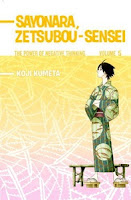My News and Reviews
After a busy week at Experiments in Manga comes a much slower one. But I was out of the state for a conference for work for most of the week, so at least I have an excuse. As you can see from the number of quick takes below, I didn’t get a chance to read nearly as much manga as I would have liked.
Last week I announced the winner of the Loveless manga giveaway. The post also includes a select list of manga license rescues in English. For those of you who have an interest in my absurd manga buying habits, April’s Bookshelf Overload has also been posted. Finally, the first in-depth manga review for May is now available for your reading pleasure. I took a look at Yoshikazu Yasuhiko’s Mobile Suit Gundam: The Origin, Volume 1: Activation. You don’t need to be a Gundam fan to enjoy the series. I’m certainly not, and yet I can’t wait for the next volume. Vertical has done a fantastic job with the release, too.
The nominees for the 2012 Shirely Jackson Award have been announced. The award recognizes “outstanding achievement in the literature of psychological suspense, horror, and the dark fantastic.” This year the nominees include Koji Suzuki’s Edge for novel (which I reviewed a couple of months ago) and Project Itoh’s The Indifference Engine for novella (which was included in the anthology The Future is Japanese.)
Elsewhere online, Sheena McNeil completed a four part series looking at gender-bending in Osamu Tezuka’s Princess Knight at Sequential Tart—Part One: Raised as a Prince, Part Two: Which Heart Should Rule?, Part Three: Challenging Gender Roles, Part Four: Discovering Herself. Since I recently held a Loveless giveaway, I thought it would be appropriate to point out Melinda Beasi’s recent Fanservice Friday feature at Manga Bookshelf—Lovesick over Loveless. Finally, The Comics Reporter interviewed Anne Ishii about her work on The Passion of Gengoroh Tagame: The Master of Gay Erotic Manga (the first collection of bara manga to ever be released in English; I’ll be reviewing it later this week.)
Quick Takes
 Sayonara, Zetsubou-Sensei: The Power of Negative Thinking, Volumes 5-8 by Koji Kumeta. Because of its quirky humor the sheer number of cultural references, Sayonara, Zetsubou-Sensei is a difficult series to recommend to just anyone. Personally I enjoy it, but then I appreciate its absurdity. I also really like Kumeta’s simple, stylized artwork. However, Sayonara, Zetsubou-Sensei does work better for me in small doses; I find that trying to read a large number of volumes all at once, while still amusing, can be rather tiresome and somewhat repetitive since Kumeta sticks to a very predictable format. Although there are some running jokes, the chapters are largely episodic so the manga is fairly easy to pick up and put down.
Sayonara, Zetsubou-Sensei: The Power of Negative Thinking, Volumes 5-8 by Koji Kumeta. Because of its quirky humor the sheer number of cultural references, Sayonara, Zetsubou-Sensei is a difficult series to recommend to just anyone. Personally I enjoy it, but then I appreciate its absurdity. I also really like Kumeta’s simple, stylized artwork. However, Sayonara, Zetsubou-Sensei does work better for me in small doses; I find that trying to read a large number of volumes all at once, while still amusing, can be rather tiresome and somewhat repetitive since Kumeta sticks to a very predictable format. Although there are some running jokes, the chapters are largely episodic so the manga is fairly easy to pick up and put down.
 Ultra-Gash Inferno by Suehiro Maruo. Unfortunately out-of-print, Ultra-Gash Inferno is one of the very few examples of Maruo’s work available in English. The volume collects nine of Maruo’s ero guro (erotic-grotesque) manga. Most of the stories in Ultra-Gash Inferno are from the early 1980s, but two, including the longest and most involved work, are from the early ’90s. While the stories are dark, violent, and filled with sexual perversion, Maruo’s artwork is gorgeous. His style is visually stunning and disconcerting and the stories are disturbing. It’s meant for mature readers and certainly isn’t for the squeamish or easily offended. Ultra-Gash Inferno is horrifying, gruesome, cruel, and beautiful.
Ultra-Gash Inferno by Suehiro Maruo. Unfortunately out-of-print, Ultra-Gash Inferno is one of the very few examples of Maruo’s work available in English. The volume collects nine of Maruo’s ero guro (erotic-grotesque) manga. Most of the stories in Ultra-Gash Inferno are from the early 1980s, but two, including the longest and most involved work, are from the early ’90s. While the stories are dark, violent, and filled with sexual perversion, Maruo’s artwork is gorgeous. His style is visually stunning and disconcerting and the stories are disturbing. It’s meant for mature readers and certainly isn’t for the squeamish or easily offended. Ultra-Gash Inferno is horrifying, gruesome, cruel, and beautiful.








